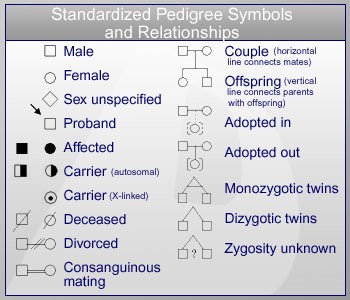Genomics at an Organism Level
To understand how characteristics of living things are passed from generation to generation, a family tree, or pedigree is often used to illustrate the movement of the characteristic through each generation. The pedigree may involve single gene inheritance or the inheritance of multifactorial traits (multiple gene and environment interaction).
Understanding a Pedigree (Family Tree) Design

A pedigree is a tool used to describe the relationships within a family; they use lines, symbols, and shading to indicate family relationships and persons with a specific trait or condition. The table above displays the different components of a pedigree.
There are many modes of inheritance for single genes, and each mode of inheritance follows a specific pedigree pattern. Below are links to example pedigrees with different modes of inheritance for single gene traits. Each of these pedigrees is designed to show the patterns for the corresponding inheritance pattern and may not be typical for rare single gene conditions. However, each page also has some real examples of human traits that typically follow this mode of inheritance. Some also include realistic pedigrees for specific conditions.
Autosomal Recessive
Autosomal Dominant
Sex(X)-linked Recessive
Sex(X)-linked Dominant
Sex Influenced Female Dominant
Sex Influenced Male Dominant
Y-linked
Sex Limited
Mitochondrial
Multifactorial Traits: Using the Pedigree as a Tool to Collect a Family History of Common Chronic Disorders
Unlike single gene disorders that are very rare, common chronic disorders such as heart disease, cancer, and diabetes may, either directly or indirectly, impact all of our lives. These conditions have been found to run in families, and scientists now know that the appearance of these disorders is influenced by our genetics, environment, and behavior.
Collecting family history with a pedigree for these chronic disorders is the first step toward prevention. Sometimes, assigning genotypes for family members at risk for multiple chronic disorders is not easy. That is because many common chronic conditions are not controlled by single genes but are multifactorial, meaning they are influenced by multiple genes and the environment. Most of our traits fall into this category. They are traits that vary slightly from individual to individual, such as height and hair color as well as common chronic conditions like heart disease, diabetes, and cancer.
Genetic Variation:
DNA is only as powerful as the proteins it produces. Proteins are products of gene expression that create our phenotype (traits and characteristics). Some genes work alone producing a protein that results in a phenotype for a single gene trait. Other genes work together along with the environment to create a phenotype for multifactorial conditions. In this situation, a certain combination of proteins (gene products) cause one phenotype while a different combination of proteins from the same genes can cause a different phenotype, resulting in genetic variation or a trait that varies slightly from individual to individual. Genes also have the ability to produce different proteins for a given trait. Each gene has multiple alleles or variations in the DNA sequence at the gene locus, which can result in variants (mutations) for that gene.
